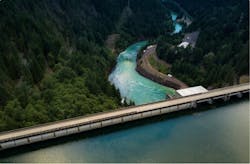How Water Utilities Can Be More Resilient During Supply Chain Disruptions
About the author:
Didem Cataloglu is CEO of Direxyon Technologies. Cataloglu can be reached via her LinkedIn here: https://www.linkedin.com/
Communities across the U.S. are being affected by aging and inadequate water infrastructures, with some of the nation’s oldest water and wastewater pipes dating as far back as the 19th century. With many pipes approaching the end of their 50- to 75-year life span, breaks are becoming more frequent. New challenges such as water scarcity are outpacing population growth. And climate change effects, unsafe potable water containing lead and other contaminants, and natural disasters are complicating matters.
In fact, the U.S. EPA reports 240,000 water main breaks every year in the U.S., costing billions in wasted energy, treated water, and all the chemicals invested in producing a water supply that is compliant with the EPA’s Safe Drinking Water Act. Every two minutes, a water main breaks and about 6 billion gallons of treated water is lost daily, according to a Utah State University study.
President Biden’s infrastructure bill is allocating $55 billion to drinking water, wastewater, and storm water funding to help resolve these issues. However, significant challenges facing water utility infrastructures are not limited to the underground. Above and beyond the 12,000 miles of aging pipelines that required replacement in 2020, the water industry is experiencing some serious supply chain disruptions placing the U.S. water system in a vulnerable position for timely maintenance and adequate levels of service.
According to a recent survey by the American Water Works Association, 72% of water utilities are facing difficulties obtaining pipes or other infrastructure components. Over 45% report issues with purchases of electronic equipment and chemicals. Many water utilities are struggling to obtain computer chips for their water trucks, as well as other vital daily supplies.
Furthermore, the EPA reports that between 2016 and 2026, approximately 10.6% of water sector workers will retire or transfer yearly, and even as much as 50% of staff will retire between 2026 and 2031.
Amid the myriad obstacles, a reactive crisis has formed – manufacturing delays, workforce turnovers, maintenance delays, investment gaps (growing to $434 billion by 2029 per the ASCE Infrastructure Report Card 2021), as well as supply chain disruptions.
Identifying Risks & Planning Ahead
On a positive note, many are embracing software that can help them navigate through climate change, population growth, lack of funding and unexpected circumstances, such as the global pandemic, that are affecting supply chains.
Three Common Asset Management Solutions for the Water Sector
Enterprise Asset Management (EAM) Systems
These are the most common management software used by utilities. They help prioritize and schedule daily operational maintenance activities.
Asset Performance Management (APM) Solutions
These solutions are further along in the analytical scale, using data from a variety of sources to identify, predict, and manage maintenance.
Asset Investment Planning (AIP) Solutions
These solutions can help water utilities proactively anticipate and prioritize risks, costs and levels of service amid aging infrastructure issues and supply chain bottlenecks. It is the most forward-looking, predictive analytics solution to help assess and address the impact of long-term issues, such as delayed supply chains. AIP solutions are designed for contingencies, analyzing eventual risks, uncertainties, and constraints.
They help utilities balance supplies, resources, levels of service, costs and associated risks as the assets evolve in their life cycle and probable contingencies. AIP helps utilities direct their investments in a sustainable and strategic way by leveraging asset life cycle simulations and assessing a range of possible outcomes.
With the right tools, companies can plan and provide for future supply chain contingencies, optimize their workforce, and save money.
Look at Supply & Demand Trends
Water utility companies need to have an accurate estimate on how long parts and supplies last to ensure readiness. What once took utilities three to six months to complete is now taking years because of low product stock, high demand and long delays in shipping.
Planning timeframes will need to adjust and the need for material to support replacements, repairs, maintenance and construction will all increase as infrastructure ages. Decision-makers will need to be mindful of this new reality, and plan for it both directly and indirectly with their partner ecosystems.
AIP solutions look at data trends to help water utility companies identify and plan for how long their assets will last. Possible risks like additional breakage, climate change and cost increases can also be factored through simulations. Water utilities can prevent situations where supply chain disruptions are anticipated and repair parts planned accordingly ahead of time.
Test Your Strategies
So, how can water utilities know their strategies are future proof? Through testing and analysis, companies can eliminate doubt and plan around contingencies.
Using what-if analysis, decision-makers can base their purchase schedules, not only on required levels of service, but also on shifting delivery schedules or availability. “What-if” scenario analysis offers utilities the ability to anticipate, plan around unexpected situations, and work with OEMs to ensure they have the necessary supplies.
Supply chain disruptions will continue to pose challenges to the industry. With water being a vital commodity, it is imperative utility companies adopt new solutions and resources for long-term planning and investment. Predictive analytics will help water utilities make sustainable and strategic decisions now and for years to come.

